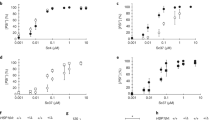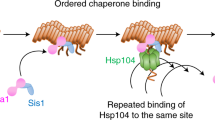Abstract
Prion proteins can adopt multiple infectious strain conformations. Here we investigate how the sequence of a prion protein affects its capacity to propagate specific conformations by exploiting our ability to create two distinct infectious conformations of the yeast [PSI+] prion protein Sup35, termed Sc4 and Sc37. PNM2, a G58D point mutant of Sup35 that was originally identified for its dominant interference with prion propagation, leads to rapid, recessive loss of Sc4 but does not interfere with propagation of Sc37. PNM2 destabilizes the amyloid core of Sc37 and causes compensatory effects that slow prion growth but aid prion division and result in robust propagation of Sc37. By contrast, PNM2 does not affect the structure or chaperone-mediated division of Sc4 but interferes with its delivery to daughter cells. Thus, effective delivery of infectious particles during cell division is a crucial and conformation-dependent step in prion inheritance.
This is a preview of subscription content, access via your institution
Access options
Subscribe to this journal
Receive 12 print issues and online access
$189.00 per year
only $15.75 per issue
Buy this article
- Purchase on Springer Link
- Instant access to full article PDF
Prices may be subject to local taxes which are calculated during checkout






Similar content being viewed by others
References
Caughey, B., Baron, G.S., Chesebro, B. & Jeffrey, M. Getting a grip on prions: oligomers, amyloids, and pathological membrane interactions. Annu. Rev. Biochem. 78, 177–204 (2009).
Chiti, F. & Dobson, C.M. Protein misfolding, functional amyloid, and human disease. Annu. Rev. Biochem. 75, 333–366 (2006).
Tuite, M.F. & Cox, B.S. Propagation of yeast prions. Nat. Rev. Mol. Cell Biol. 4, 878–890 (2003).
Tessier, P.M. & Lindquist, S. Unraveling infectious structures, strain variants and species barriers for the yeast prion [PSI+]. Nat. Struct. Mol. Biol. 16, 598–605 (2009).
Chien, P., Weissman, J.S. & DePace, A.H. Emerging principles of conformation-based prion inheritance. Annu. Rev. Biochem. 73, 617–656 (2004).
Santoso, A., Chien, P., Osherovich, L.Z . & Weissman, J.S . Molecular basis of a yeast prion species barrier. Cell 100, 277–288 (2000).
Morales, R., Abid, K. & Soto, C. The prion strain phenomenon: molecular basis and unprecedented features. Biochim. Biophys. Acta 1772, 681–691 (2007).
Tanaka, M., Chien, P., Naber, N., Cooke, R. & Weissman, J.S. Conformational variations in an infectious protein determine prion strain differences. Nature 428, 323–328 (2004).
Derkatch, I.L., Chernoff, Y.O., Kushnirov, V.V., Inge-Vechtomov, S.G. & Liebman, S.W. Genesis and variability of [PSI] prion factors in Saccharomyces cerevisiae. Genetics 144, 1375–1386 (1996).
Bradley, M.E., Edskes, H.K., Hong, J.Y., Wickner, R.B. & Liebman, S.W. Interactions among prions and prion “strains” in yeast. Proc. Natl. Acad. Sci. USA 99 Suppl 4, 16392–16399 (2002).
King, C.-Y. & Diaz-Avalos, R. Protein-only transmission of three yeast prion strains. Nature 428, 319–323 (2004).
Chien, P. & Weissman, J. Conformational diversity in a yeast prion dictates its seeding specificity. Nature 410, 223–227 (2001).
Sparrer, H.E., Santoso, A., Szoka, F.C. & Weissman, J.S. Evidence for the prion hypothesis: induction of the yeast [PSI+] factor by in vitro-converted Sup35 protein. Science 289, 595–599 (2000).
Krishnan, R. & Lindquist, S.L. Structural insights into a yeast prion illuminate nucleation and strain diversity. Nature 435, 765–772 (2005).
Toyama, B.H., Kelly, M.J., Gross, J.D. & Weissman, J.S. The structural basis of yeast prion strain variants. Nature 449, 233–237 (2007).
Tanaka, M., Collins, S.R., Toyama, B.H. & Weissman, J.S. The physical basis of how prion conformations determine strain phenotypes. Nature 442, 585–589 (2006).
Derkatch, I.L., Bradley, M.E., Zhou, P. & Liebman, S.W. The PNM2 mutation in the prion protein domain of SUP35 has distinct effects on different variants of the [PSI+] prion in yeast. Curr. Genet. 35, 59–67 (1999).
Green, K.M. et al. The elk PRNP codon 132 polymorphism controls cervid and scrapie prion propagation. J. Gen. Virol. 89, 598–608 (2008).
Takemura, K., Kahdre, M., Joseph, D., Yousef, A. & Sreevatsan, S. An overview of transmissible spongiform encephalopathies. Anim. Health Res. Rev. 5, 103–124 (2004).
Zeidler, M., Stewart, G., Cousens, S.N., Estibeiro, K. & Will, R.G. Codon 129 genotype and new variant CJD. Lancet 350, 668 (1997).
Mead, S. et al. Creutzfeldt-Jakob disease, prion protein gene codon 129VV, and a novel PrPSc type in a young British woman. Arch. Neurol. 64, 1780–1784 (2007).
Collinge, J., Sidle, K.C., Meads, J., Ironside, J. & Hill, A.F. Molecular analysis of prion strain variation and the aetiology of 'new variant' CJD. Nature 383, 685–690 (1996).
Hill, A.F. et al. The same prion strain causes vCJD and BSE. Nature 389, 448–450 (1997).
Doel, S.M., McCready, S.J., Nierras, C.R. & Cox, B.S. The dominant PNM2- mutation which eliminates the psi factor of Saccharomyces cerevisiae is the result of a missense mutation in the SUP35 gene. Genetics 137, 659–670 (1994).
Young, C.S.H. & Cox, B.S. Extrachromosomal elements in a super-suppression system of yeast: I. A nuclear gene controlling the inheritance of the extrachromosomal elements. Heredity 26, 413–422 (1971).
Chernoff, Y., Lindquist, S., Ono, B., Inge-Vechtomov, S. & Liebman, S. Role of the chaperone protein Hsp104 in propagation of the yeast prion-like factor [psi+]. Science 268, 880–884 (1995).
Kochneva-Pervukhova, N.V. et al. Mechanism of inhibition of Psi+ prion determinant propagation by a mutation of the N-terminus of the yeast Sup35 protein. EMBO J. 17, 5805–5810 (1998).
Glover, J.R. et al. Self-seeded fibers formed by Sup35, the protein determinant of [PSI+], a heritable prion-like factor of S. cerevisiae. Cell 89, 811–819 (1997).
King, C.Y. et al. Prion-inducing domain 2–114 of yeast Sup35 protein transforms in vitro into amyloid-like filaments. Proc. Natl. Acad. Sci. USA 94, 6618–6622 (1997).
Higurashi, T., Hines, J.K., Sahi, C., Aron, R. & Craig, E.A. Specificity of the J-protein Sis1 in the propagation of 3 yeast prions. Proc. Natl. Acad. Sci. USA 105, 16596–16601 (2008).
Jones, G.W. & Tuite, M.F. Chaperoning prions: the cellular machinery for propagating an infectious protein? Bioessays 27, 823–832 (2005).
Shorter, J. & Lindquist, S. Hsp104, Hsp70 and Hsp40 interplay regulates formation, growth and elimination of Sup35 prions. EMBO J. 27, 2712–2724 (2008).
Tipton, K.A., Verges, K.J. & Weissman, J.S. In vivo monitoring of the prion replication cycle reveals a critical role for Sis1 in delivering substrates to Hsp104. Mol. Cell 32, 584–591 (2008).
Tessarz, P., Mogk, A. & Bukau, B. Substrate threading through the central pore of the Hsp104 chaperone as a common mechanism for protein disaggregation and prion propagation. Mol. Microbiol. 68, 87–97 (2008).
Hung, G.-C. & Masison, D.C. N-terminal domain of yeast Hsp104 chaperone is dispensable for thermotolerance and prion propagation but necessary for curing prions by Hsp104 overexpression. Genetics 173, 611–620 (2006).
Di Salvo, S., Derdowski, A., Pezza, J.A. & Serio, T.R. Dominant prion mutants induce curing through pathways that promote chaperone-mediated disaggregation. Nat. Struct. Mol. Biol. advance online publication, doi:10.1038/nsmb.2031 (20 March 2011).
Kryndushkin, D.S., Alexandrov, I.M., Ter-Avanesyan, M.D. & Kushnirov, V.V. Yeast [PSI+] prion aggregates are formed by small Sup35 polymers fragmented by Hsp104. J. Biol. Chem. 278, 49636–49643 (2003).
Cox, B., Ness, F. & Tuite, M. Analysis of the generation and segregation of propagons: entities that propagate the [PSI+] prion in yeast. Genetics 165, 23–33 (2003).
Ferreira, P.C., Ness, F., Edwards, S.R., Cox, B.S. & Tuite, M.F. The elimination of the yeast [PSI+] prion by guanidine hydrochloride is the result of Hsp104 inactivation. Mol. Microbiol. 40, 1357–1369 (2001).
Grimminger, V., Richter, K., Imhof, A., Buchner, J. & Walter, S. The prion curing agent guanidinium chloride specifically inhibits ATP hydrolysis by Hsp104. J. Biol. Chem. 279, 7378–7383 (2004).
Jung, G. & Masison, D.C. Guanidine hydrochloride inhibits Hsp104 activity in vivo: a possible explanation for its effect in curing yeast prions. Curr. Microbiol. 43, 7–10 (2001).
Byrne, L.J. et al. The number and transmission of [PSI] prion seeds (Propagons) in the yeast Saccharomyces cerevisiae. PLoS ONE 4, e4670 (2009).
Liu, B. et al. The polarisome is required for segregation and retrograde transport of protein aggregates. Cell 140, 257–267 (2010).
Kaganovich, D., Kopito, R. & Frydman, J. Misfolded proteins partition between two distinct quality control compartments. Nature 454, 1088–1095 (2008).
Robertson, A.S. et al. The WASP homologue Las17 activates the novel actin-regulatory activity of Ysc84 to promote endocytosis in yeast. Mol. Biol. Cell 20, 1618–1628 (2009).
Tonikian, R. et al. Bayesian modeling of the yeast SH3 domain interactome predicts spatiotemporal dynamics of endocytosis proteins. PLoS Biol. 7, e1000218 (2009).
Madania, A. et al. The Saccharomyces cerevisiae homologue of human Wiskott-Aldrich syndrome protein Las17p interacts with the Arp2/3 complex. Mol. Biol. Cell 10, 3521–3538 (1999).
Ganusova, E.E. et al. Modulation of prion formation, aggregation, and toxicity by the actin cytoskeleton in yeast. Mol. Cell. Biol. 26, 617–629 (2006).
Bailleul, P., Newnam, G., Steenbergen, J. & Chernoff, Y. Genetic study of interactions between the cytoskeletal assembly protein Sla1 and prion-forming domain of the release factor Sup35 (eRF3) in Saccharomyces cerevisiae. Genetics 153, 81 (1999).
Lin, C.H., Macgurn, J.A., Chu, T., Stefan, C.J. & Emr, S.D. Arrestin-related ubiquitin-ligase adaptors regulate endocytosis and protein turnover at the cell surface. Cell 135, 714–725 (2008).
Nikko, E. & Pelham, H.R.B. Arrestin-mediated endocytosis of yeast plasma membrane transporters. Traffic 10, 1856–1867 (2009).
Derdowski, A., Sindi, S.S., Klaips, C.L., Disalvo, S. & Serio, T.R. A size threshold limits prion transmission and establishes phenotypic diversity. Science 330, 680–683 (2010).
Tanaka, M., Chien, P., Yonekura, K. & Weissman, J.S. Mechanism of cross-species prion transmission: an infectious conformation compatible with two highly divergent yeast prion proteins. Cell 121, 49–62 (2005).
Halfmann, R. & Lindquist, S. Screening for amyloid aggregation by semi-denaturing detergent-agarose gel electrophoresis. J. Vis. Exp. 16, 838 (2008).
Bagriantsev, S.N., Kushnirov, V.V. & Liebman, S.W. Analysis of amyloid aggregates using agarose gel electrophoresis. Methods Enzymol. 412, 33–48 (2006).
Acknowledgements
We thank B. Bukau, A. Mogk and P. Tessarz for reagents; M. Kelly for NMR assistance; D. Cameron, S. Collins, C. Gross, D. Mullins, G. Narlikar, M. Tanaka and K. Tipton for discussions; and O. Brandman, C. Foo, A. Frost, N. Ingolia, E. Oh, E. Quan and E. Rodriguez for critical reading of the manuscript. This work was funded by the Howard Hughes Medical Institute (J.S.W.), the National Science Foundation Graduate Research Fellowship program (K.J.V.), the Hertz Foundation Peter Strauss Fellowship (M.H.S.) and the US National Institutes of Health.
Author information
Authors and Affiliations
Contributions
K.J.V., M.H.S. and J.S.W. designed this study and wrote the manuscript. J.S.W. supervised this work. K.J.V. and M.H.S. conducted the majority of the experiments. B.H.T. designed the H/X NMR experiments and acquired and analyzed the NMR data.
Corresponding author
Ethics declarations
Competing interests
The authors declare no competing financial interests.
Supplementary information
Supplementary Text and Figures
Supplementary Figures 1 and 2, Supplementary Tables 1 and 2, and Supplementary Methods (PDF 2707 kb)
Rights and permissions
About this article
Cite this article
Verges, K., Smith, M., Toyama, B. et al. Strain conformation, primary structure and the propagation of the yeast prion [PSI+]. Nat Struct Mol Biol 18, 493–499 (2011). https://doi.org/10.1038/nsmb.2030
Received:
Accepted:
Published:
Issue Date:
DOI: https://doi.org/10.1038/nsmb.2030
This article is cited by
-
Evidence of distinct α-synuclein strains underlying disease heterogeneity
Acta Neuropathologica (2021)
-
Fibril formation and therapeutic targeting of amyloid-like structures in a yeast model of adenine accumulation
Nature Communications (2019)
-
The life of [PSI]
Current Genetics (2018)
-
Analytical model for macromolecular partitioning during yeast cell division
BMC Biophysics (2014)
-
Solid-state NMR sequential assignments of the amyloid core of Sup35pNM
Biomolecular NMR Assignments (2014)



